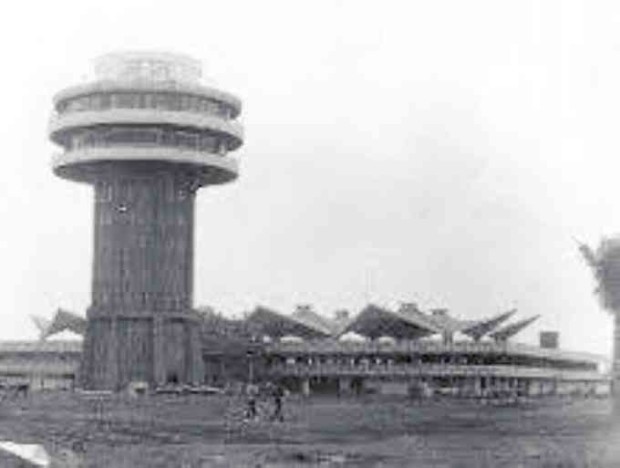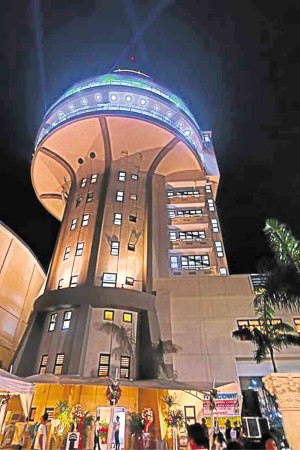Saved from decay, Pasig landmark is back in business

GLEAMING COMEBACK After a makeover that was first planned in 2006, the newly restored structure is
now brighter and one floor higher—but still keeping the mushroom shape that made it a Pasig icon in the 1970s
(lower photo). —PHOTOS FROM PASIG CITY PIO
Back in the 1970s, in an area mostly surrounded by rice fields and a scattering of houses, the 11-story structure stood tall and proud as Pasig’s landmark and symbol of progress.
Built during the term of then Mayor Emiliano Caruncho Jr., the mushroom-shaped building was already considered a towering marvel by the engineering standards of the day, overlooking the sprawling Mutya ng Pasig public market.
It held the distinction of housing one of the only two revolving restaurants operating in the country during that period. The other was at Manila Royal Hotel in Quiapo.
But unlike its Manila counterpart, Pasig’s Revolving Tower remains standing, despite falling into neglect for two decades and serving as silent witness to the city’s rapid urbanization.
After a P120-million rehabilitation effort initiated by the city government a decade ago, the tower was reopened to the public on Monday, with a fresh look welcoming Pasiguenos who are aware of its history.
Article continues after this advertisementModern lighting systems make the structure gleam at night, crowning its revival as a hometown icon. From its roof deck, visitors can once again get a 360-degree view of Pasig as well as a panoramic vista that extends to Laguna de Bay and neighboring Cainta, Antipolo, Taytay, Makati, Quezon City.
Article continues after this advertisementCrisis and decay
According to Noel Rivera, a historian and director of the Pasig City Museum, the tower built in 1974 mainly hosted the revolving restaurant and other concessionaires during its heyday.
But the economic crisis in the 1980s, particularly after the assassination of former Sen. Benigno Ninoy Aquino Jr. in 1983, saw its tenants losing money and unable to pay rent to the city government, Rivera recalled.
The Revolving Tower gradually became a mere shell of its old self, with only its first three floors occupied by local government departments. For several years, it even served as a detention center and a storage area for goods sold at the adjoining market, according to Ireneo Moralita, the project engineer in charge of the restoration.
“It became such a waste and had no use for 20 years,” Moralita recalled.
That was until two mayors—who are both architects—saw and ensured a future for the decaying structure.
Early studies

GLEAMING COMEBACK After a makeover that was first planned in 2006, the newly restored structure is
now brighter and one floor higher—but still keeping the mushroom shape that made it a Pasig icon in the 1970s
(lower photo). —PHOTOS FROM PASIG CITY PIO
The restoration work took years to plan and execute. From 2006 to 2008, Mayor Robert Eusebio commissioned an architectural and structural study of the tower.
Actual rehabilitation works finally got underway in 2015 under the mayoralty of his wife Maribel and were completed this year, again under Robert, who was reelected mayor in May.
Moralita noted that the original structure built more than 40 years ago had remained sturdy, thanks to the materials used, and withstood earthquakes through the years. The partitions and the flooring were the parts that required much work, he said.
The study for the restoration underwent several revisions, Moralita said, for the goal was not just to physically rebuild the tower but to turn a “white elephant” into something commercially viable.
Interbelt Construction, the lead contractor, added a 12th floor and a viewing deck, he added.
Repurposed
Those who last entered the tower when it was still in full operation may recognize the old layout since most of the changes are in the interior designs per floor, according to architect Alfredo Saman Jr. of the city engineering office. Improvements have been made on the facade, stairway, and elevator, while additional features include a communication tower, a water tank and a garbage chute.
The new tower is now being repurposed to house the Market Administration and Tourism offices, as well as a “Museum of Local and Modern Art (Molma)”, Rivera said.
The 12th floor will soon serve as an extension office of City Hall’s communication unit, while the 4th to 8th floors will also be converted into Molma galleries.
The 11th level will be retained as the floor for a revolving restaurant, while the 10th floor will soon host a coffee shop, Rivera added.
Former Mayor Maribel Eusebio, who hosted a party with city councilors on Friday night to celebrate the tower’s rebirth, said the project was not just about restoring an old building but educating the youth about the city’s heritage and culture, while creating more jobs for Pasiguenos.
The Pasig Revolving Tower is now open to businessmen who want to rent space, Moralita said.
